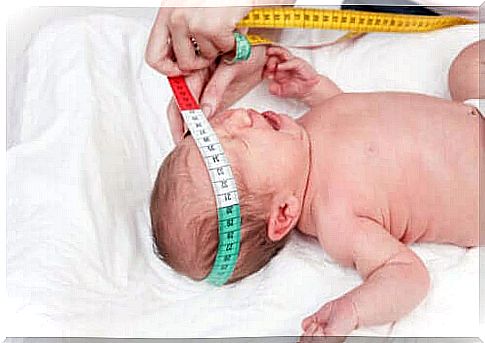Why Do Pediatricians Measure Your Baby’s Head At Birth?

The cephalic circumference is the measurement of your baby’s head taken at birth and at each health check-up. The purpose of this practice is to detect changes in skull size, called microcephaly and macrocephaly.
When the child’s head is abnormally sized, it may be an indication of a nervous system disease. It is therefore important to closely monitor the child and evaluate the need for additional studies or the consultation of other specialists.
In this article we will therefore tell you why the first measurement of the head circumference is so important.
Why is it important to measure your baby’s head?
The size of a baby’s head at birth gives doctors an idea of how the nervous system has developed during pregnancy.
To better understand this idea, we need to understand what structures this system consists of and how it develops in the womb.
Anatomy of the Central Nervous System (CNS)
The central nervous system consists of several structures, among which we can highlight the following:
- The big brain.
- The cerebellum, the brainstem, the spinal cord.
- Cerebrospinal fluid (circulates in reservoirs or ducts).
- The skull (bones and cartilage).
Fetal Central Nervous System Development

In those cases where the brain undergoes some change and does not develop properly, it will also affect the growth of the bones of the head. For example, if the mother catches a certain infection during pregnancy, the baby may be born with a smaller skull than normal. This is known as microcephaly.
In turn, there may be some kind of obstruction in the system of ducts that carry the cerebrospinal fluid. As a result, this content accumulates in the area before the blockage and puts pressure on other structures.
Indirectly this causes a ‘stretching’ of the cranial cavity. As a result, the baby will be born with a skull that is larger than normal. This is known as macrocephaly.
In either case, the baby is born with an abnormal head circumference. While not a problem in itself, it indicates that some change has occurred during fetal neurodevelopment.
How do doctors measure your baby’s head and why?
Head circumference is a simple measurement of the circumference of the baby’s head. Doctors use a soft tape measure, which they place around the skull in the area of greatest circumference. This is located at the height of the forehead (front), the temples (sides) and the back of the head (back).

Ideally, doctors should perform the procedure with the baby’s head upright. However, as this is very difficult to achieve in newborns, they take it with the baby lying on his back on the exam table.
Although many babies cry during the initial examination in the delivery room, this is not an indication of any risk or physical condition.
The importance of performing this measurement in the first 24 hours after birth is to indirectly evaluate how the central nervous system has developed in the womb.
It will also alert us to any possibility of syndromic congenital diseases (those consisting of various defects), such as Down syndrome.
The size of your baby’s head
Head circumference, weight, and height (height) are part of your baby’s “intrauterine history.” With these measurements, we can deduce whether the baby has been exposed to risk factors for disease and act accordingly.
So, to find out whether the baby was born with a head of sufficient size or not, we should always refer to the corresponding growth charts. In these graphs we find the measurements of hundreds of children from different parts of the world, which allowed us to estimate the average growth for each age and gender.
When we measure the baby’s head circumference, we need to compare this data with the tables and define the percentile where the child is. In this way we can see whether the baby has a skull of average size or not.
We now define the 3 possibilities:
- Normocephalic: when the head circumference percentile is between 3 and 97.
- Microcephalic (English link): when the percentile is less than 3
- Macrocephalic: when the percentile is greater than 97
Possible problems
Microcephaly and macrocephaly can occur for several reasons. These can be problems that directly affect brain growth (called primary defects) or cause changes in the head circumference for other reasons (called secondary defects).
Causes of Microcephaly
The most common causes of neonatal microcephaly include the following:
- Genetic syndromes, such as Down syndrome, Edwards, or Patau.
- Primary developmental disorders in the brain
- Perinatal infections, such as chickenpox, toxoplasmosis, or rubella
- Zika virus
- Exposure to toxins or radiation during pregnancy
- Severe intrauterine malnutrition
Causes of Macrocephaly
The following are the most common causes of neonatal macrocephaly:
- Familial macrocephaly
- Genetic brain abnormalities
- Sotos syndrome
- achondroplasia
- Neurofibromatosis
- Hematomas, cysts or brain haemorrhages
- Congenital hydrocephalus
- Encephal tumors
On the importance of measuring a baby’s head
Doctors determine head circumference by measuring a baby’s head. It then allows them to deduce whether the brain has developed correctly in the womb.
It is a simple, inexpensive, minimally invasive and painless strategy for the early detection of major pathologies in neonates. In addition, it will sometimes warn of the possibility of other associated defects, such as those that are part of syndromes.
Measuring head circumference at birth is very important, but it is something that should also be done at every subsequent health check. Some pathologies are evolutionary and take a long time to manifest. With this simple measurement, we can detect them before they become a difficult problem to solve.









